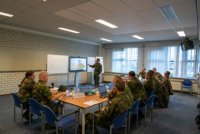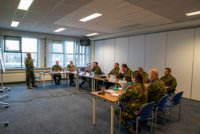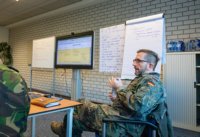CIMIC Messenger 2024-01
Dear Reader,
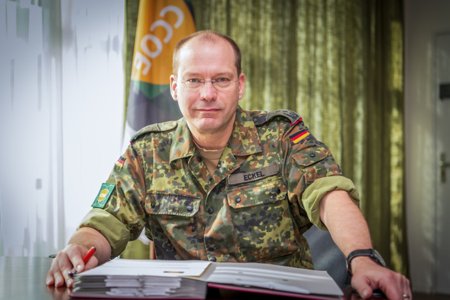
As we embark on the journey into the promising and challenging year of 2024, the Civil-Military Cooperation Centre of Excellence (CCOE) extends some exciting news and thoughts to all our esteemed colleagues, partners, and friends. In this messenger, we are delighted to share some noteworthy updates and insights from the CIMIC domain and the CCOE itself. The year has unfolded energetically, with our collective endeavours fuelled by the commitment to address the challenges ahead. Currently, two major conflicts persist, encompassing regional and global implications that underscore the significance of our collaborative efforts within the discipline of civil–military cooperation. Looking ahead, 2024 promises a year of substantial exercises and key summits, further emphasizing the critical role of cooperation within our Alliance. Recognizing that the civil environment is integral to all military activities, we are dedicated to enhancing our understanding and preparation. Through focused activities such as training, education, simulation & wargaming and active engagement with academia and other stakeholders, including our long-lasting counterparts like the USA Civil Affairs, we aim to develop further and enhance the capabilities and utility of our forces. The exchange of ideas and experiences with sister organizations and the CIMIC community of interest plays a pivotal role in shaping our collective effectiveness.
Furthermore, we are excited to share recent developments within the CCOE and CIMIC, including the reactivation of a sponsoring nation, key events such as the annual discipline conference, and our regular assessments – to name just a few. These elements contribute significantly to the utility of our organization, ensuring its relevance and excellence. We invite you to join us on this insightful journey through the diverse activities and developments in the CIMIC and CCOE realms. We hope the information shared will be valuable and contribute to a deeper understanding of our common goals.
We look forward to your active participation and hope to welcome you in person to The Hague.
Thank you for your time, and let us collectively strive for a year of fruitful collaboration and accomplishments.
Best Regards,
Colonel Andreas Eckel
DIRECTOR CCOE
Topics in this CIMIC messenger
- T&E: Courses in 2024
- T&E activities in 2024!
- Scenario adaptation: the way forward!
- The Annual Discipline Conference…..what about it?
- NATO CIMIC vs US Civil Affairs
- Periodic Assessment
- The Israel-Hamas Conflict – Civil-Military Implications
- Academic Network & Partnership Forum
- Exploring the Power of CIMIC: A Journey through the upcoming CCOE Webinar Series Events
- AJP 3.19 CIMIC Roadshow
- Civil-Military Cooperation in Multi-Domain Operations
- The new CIMIC Handbook
- Dobrodošli Slovenija - Welcome Slovenia
- CIMIC wargaming for mission success in crisis and conflict scenarios
Training & Education: Courses in 2024
Who are we?
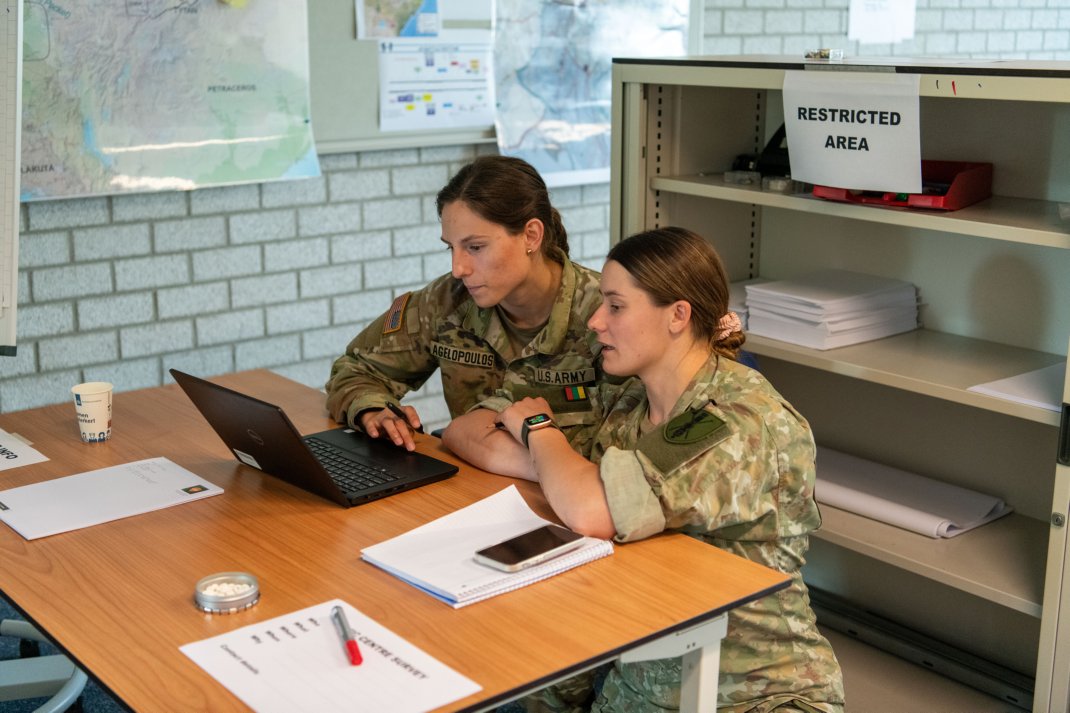
The CIMIC Centre of Excellence (CCOE) is the main centre for advanced training of the military as well as non-military personnel in the discipline of NATO CIMIC. The CCOE also ensures that its advanced trainings are conducted within the terms of corresponsive NATO regulations, which are also regularly reviewed and refined by the CCOE. Furthermore, it is a matter of designing the most comprehensive and holistic training possible based on the requirements of the NATO command structure.
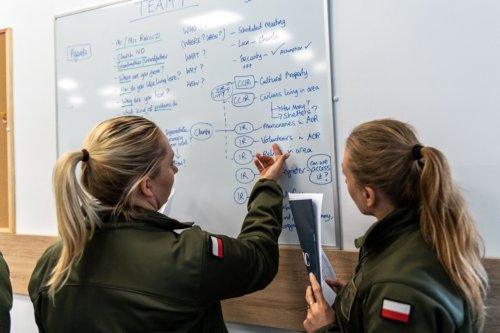
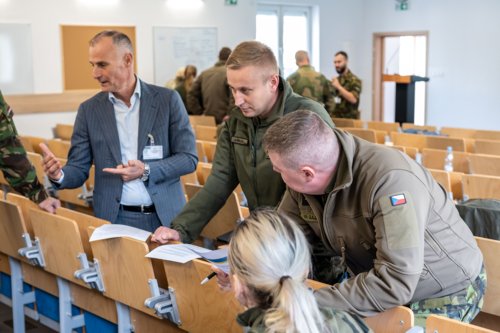
The CCOE trains a range of 350 to 500 trainees per year, coming from all NATO states, as well as other NATO partnership program nations and civil organizations. Per the CCOE’s Program of Work (POW), the Training and Education Branch (T&E) offers various courses with various content for different levels of participation.
The courses aim from the tactical level up to the intermediate and advanced operational level with a particular degree of specialization, e.g. in the field of Liaison or Analysis and Assessment. Our instructors are highly experienced and well trained, and they are being supplemented by the finest subject matter experts who can even meet the highest demands of our course participants.
Training & Education activities in 2024
In 2024, the T&E branch will provide an extra iteration of the NATO CIMIC Higher Command Course (NCHCC), responding to the high level of demand for that specific high-level course. Being one of our diamond courses, the demand exceeds the usually offered two iterations. An extra iteration seems to be necessary in order to be able to train a large number of potential candidates.
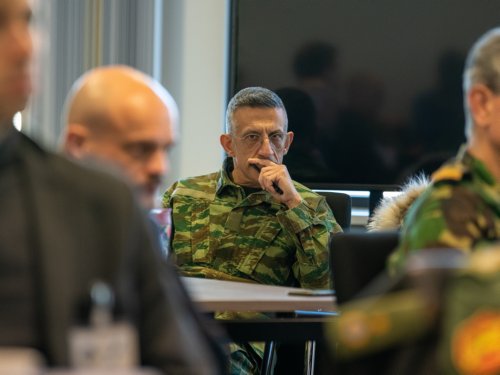 So in 2024, three iterations of the NCHCC are planned. On Sponsoring Nations (SN) request, T&E will also support five satellite courses. This year, two iterations of the Resilience Through Civil Preparedness Course (RtCPC) will be conducted in Italy and Germany. Two iterations of the NATO CIMIC Liaison Course (NCLC) in Art 4/5 will take place in Hungary and Poland. One iteration of the NATO CIMIC Field Workers Course (NCFWC) will be organized in Latvia. Besides executing the in-house and satellite courses, T&E will also support the US Civil Affairs (CA) Captains Careers Course (CCC) and the European Mission Preparation Course (EMPC) for CA units deploying to NATO nations in Europe. On request and within its means and capabilities, T&E will also send Mobile Training Teams (MTT) to provide tailored courses for SN and other NATO and non-NATO partners.
So in 2024, three iterations of the NCHCC are planned. On Sponsoring Nations (SN) request, T&E will also support five satellite courses. This year, two iterations of the Resilience Through Civil Preparedness Course (RtCPC) will be conducted in Italy and Germany. Two iterations of the NATO CIMIC Liaison Course (NCLC) in Art 4/5 will take place in Hungary and Poland. One iteration of the NATO CIMIC Field Workers Course (NCFWC) will be organized in Latvia. Besides executing the in-house and satellite courses, T&E will also support the US Civil Affairs (CA) Captains Careers Course (CCC) and the European Mission Preparation Course (EMPC) for CA units deploying to NATO nations in Europe. On request and within its means and capabilities, T&E will also send Mobile Training Teams (MTT) to provide tailored courses for SN and other NATO and non-NATO partners.
Last but certainly not least, T&E, in close cooperation with the Concept Interoperability Capabilities (CIC) branch and the Lesson Learned and Analysis (LL&A) branch, will support NATO exercises such as STEADFAST DAGGER and STEADFAST DUEL with SMEs and national CIMIC exercises such as COMMON GROUND and JOINT COOPERATION as part of exercise evaluation. So again a busy, challenging but very interesting year on the Education, Training, Exercises and Evaluation (ETEE) side of the CCOE!
See you in the Hague!
Scenario adaptation: the way forward!
Since 2011, twice a year, the NATO CIMIC Higher Command Course (NCHCC) prepares Strategic, Operational and High Tactical level CIMIC Staff to contribute to their headquarters’ staff processes during the planning and execution of daily activities, missions and operations. The course is a successful result of blended learning, based on a mix of conferences, syndicate work with open discussions, war-gaming and modelling and simulation, all supported by experienced coaches and subject-matter experts and referenced within a scenario to support the course objectives.
Throughout the years, the content of the course has constantly been updated to keep up to speed with new policies, new doctrines and changing organisations. Following NATO’s recalibration from crisis response to collective defence after Russia’s illegal annexation of Crimea in 2014, the course went through a complete revision between 2017 and 2019 to correspond better with the (re-)orientation of the Alliance's focus vis-à-vis the course objectives.
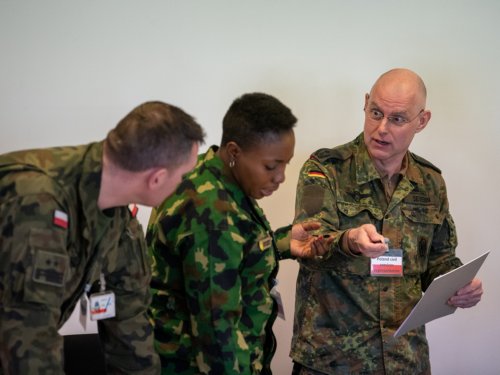 After 24 February 2022, it became clear that the entire NATO Education, Training, Exercises and Evaluation (ETEE) landscape, hence the focus and content of the NCHCC, should make a shift towards CIMIC in Deterrence, High Intensity, Collective Defence war-fighting settings. This would include a holistic review of the basic scenario settings, resulting in either the integration of a new or the revision of the current scenario. In 2023 and 2024, the CCOE further investigated the best practices for approaching this issue. After extensive consultation and exchange with numerous NATO scenario experts and other NATO training and education institutions (such as Joint Warfare Centre or NATO School Oberammergau), the constraints and restraints of using a full-scale scenario which encompasses all aspects of collective defence because elements of this scenario are classified. To train the crucial aspects of CIMIC in collective defence, the CCOE will start revising its courses to a certain extent. Still using the original scenario, but tailor and adapt it in such a way that the relevant themes and topics will promote that parallels and key learning objectives can be drawn to CIMIC in collective defence and high-intensity conflict. The NCHCC is the first course to get revised in that way. Starting with minor changes in the first iteration in 2024 and finalising this course revision in the 3rd and last iteration of 2024. Parallel to the NCHCC, the entire course landscape will be reviewed in that context. A necessary step in order to stay up to date and be able to maintain the high quality of our courses!
After 24 February 2022, it became clear that the entire NATO Education, Training, Exercises and Evaluation (ETEE) landscape, hence the focus and content of the NCHCC, should make a shift towards CIMIC in Deterrence, High Intensity, Collective Defence war-fighting settings. This would include a holistic review of the basic scenario settings, resulting in either the integration of a new or the revision of the current scenario. In 2023 and 2024, the CCOE further investigated the best practices for approaching this issue. After extensive consultation and exchange with numerous NATO scenario experts and other NATO training and education institutions (such as Joint Warfare Centre or NATO School Oberammergau), the constraints and restraints of using a full-scale scenario which encompasses all aspects of collective defence because elements of this scenario are classified. To train the crucial aspects of CIMIC in collective defence, the CCOE will start revising its courses to a certain extent. Still using the original scenario, but tailor and adapt it in such a way that the relevant themes and topics will promote that parallels and key learning objectives can be drawn to CIMIC in collective defence and high-intensity conflict. The NCHCC is the first course to get revised in that way. Starting with minor changes in the first iteration in 2024 and finalising this course revision in the 3rd and last iteration of 2024. Parallel to the NCHCC, the entire course landscape will be reviewed in that context. A necessary step in order to stay up to date and be able to maintain the high quality of our courses!
The Annual Discipline Conference…..what about it?
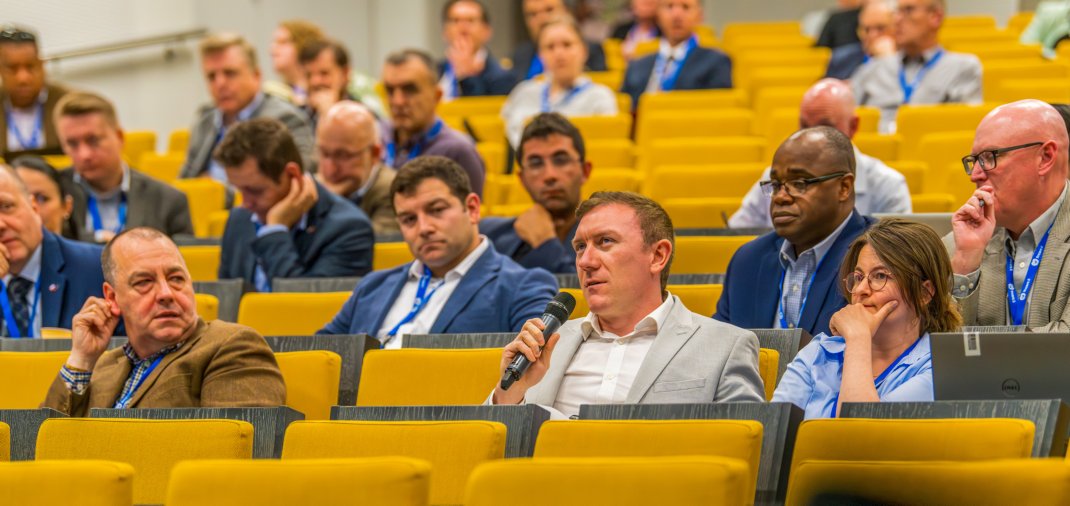
The Annual Discipline Conference (ADC) is a yearly recurring event where the CIMIC community gathers to be informed and exchange views about the latest developments in CIMIC Education and Training and other associated and related topics like the latest developments in concepts and doctrine. The Department Head (DH) of the CIMIC & CMI Discipline, which has been covered by the CCOE since 2015, is responsible for organizing this event. A DH supports Headquarters Supreme Allied Commander Transformation’s (HQ SACT’s) responsibility for translating NATO Education & Training requirements into solutions for the individual and collective training spectrum. Furthermore, the DH will assemble a discipline education & training program. Acting as DH means that the CCOE has sufficient expertise in this discipline to manage training solutions and is taking part in quality assurance processes. In line with the revised AJP 3.19, the CIMIC and CMI discipline will shift to the CIMIC discipline. CMI, next to CFI (Civil Factor Integration), will be a CIMIC core activity. CIMIC, therefore, enables, conducts and facilitates CMI (Civil-Military Interaction)and integrates an understanding of the civil factors of the operating environment by CFI.
NATO has 28 Disciplines, and all are governed by a Requirement Authority (RA). The RA for the CIMIC discipline is Assistant Chief of Staff (ACOS) J9 SHAPE. The DH is under the control of HQ ACT and, in particular, under the JFD (Joint Force Development) Branch. NATO has defined this in a formal process called Global Programming. Global Programming is how NATO manages the training needs of personnel from member and partner nations above national training to provide tailored training solutions to satisfy all NATO requirements. This system develops, controls and reviews Education, Training, Exercises and Evaluation (ETEE) within a Discipline. In this regard, the RA sets what is required, and the DH looks for the appropriate and approved solution to realize this requirement in the form of individual and collective training.
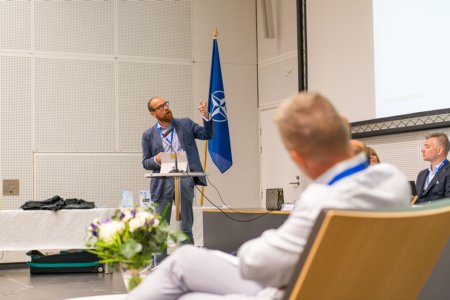 The primary process within Global Programming starts by developing requirements for jobs in CIMIC positions in NATO units, HQs and missions. In principle, this is done one time for each Discipline by drafting a Training Requirements Analysis (TRA). In the CIMIC & CMI Discipline, SHAPE J9 is the one that sets these requirements. The TRA is reviewed every year by looking for changes in requirements and, when there are, to see whether adaptations in existing training solutions are necessary. Then, the DH will organize an ADC later that year for the community of interest in their Discipline, i.e., colleagues working on CIMIC posts and institutes providing CIMIC training. At the ADC, the DH will present the ‘alignment’. So, what is new in the Discipline when it comes to ETEE solutions? Are these solutions still in concert with the qualification process to ensure that these solutions still fit the requirements? It is also an excellent opportunity to discuss topics that affect the ETEE of the discipline and constitute the culmination point of the whole process. Since 2022, the ADC has been organised in a co-located setting together with The Finnish Defence Forces International Centre (FINCENT) and took place in Helsinki, Finland, in 2023. FINCENT is responsible for the discipline of Military Contribution to Peace Support (MC2PS). Next to MC2PS, CIMIC is also working closely together with two other disciplines. These are Gender in Military Operations (GMO) and Building Integrity (BI).
The primary process within Global Programming starts by developing requirements for jobs in CIMIC positions in NATO units, HQs and missions. In principle, this is done one time for each Discipline by drafting a Training Requirements Analysis (TRA). In the CIMIC & CMI Discipline, SHAPE J9 is the one that sets these requirements. The TRA is reviewed every year by looking for changes in requirements and, when there are, to see whether adaptations in existing training solutions are necessary. Then, the DH will organize an ADC later that year for the community of interest in their Discipline, i.e., colleagues working on CIMIC posts and institutes providing CIMIC training. At the ADC, the DH will present the ‘alignment’. So, what is new in the Discipline when it comes to ETEE solutions? Are these solutions still in concert with the qualification process to ensure that these solutions still fit the requirements? It is also an excellent opportunity to discuss topics that affect the ETEE of the discipline and constitute the culmination point of the whole process. Since 2022, the ADC has been organised in a co-located setting together with The Finnish Defence Forces International Centre (FINCENT) and took place in Helsinki, Finland, in 2023. FINCENT is responsible for the discipline of Military Contribution to Peace Support (MC2PS). Next to MC2PS, CIMIC is also working closely together with two other disciplines. These are Gender in Military Operations (GMO) and Building Integrity (BI).
The 2024 ADC will take place from 4-6 June in the Hague and is hosted by the CCOE. This conference is again co-located with the discipline MC2PS. This year, even three disciplines are present as BI will attend, and the conference grows to a triple co-located event – all disciplines have the mutual relationship between the military and the civilian environment as a key element. So don’t miss this unique opportunity to see three disciplines in one co-located ADC. We will keep the community of interest updated on that one!
NATO CIMIC and US Civil Affairs
Mutual understanding between NATO Civil-Military Cooperation (CIMIC) and US Civil Affairs (CA)
Did you ever wonder why the CIMIC Centre of Excellence (CCOE), representing NATO CIMIC, and US Civil Affairs (CA) cooperate and mutually support each other so intensively? CIMIC and US CA are the eyes and ears of their respective supported commander, focusing on the civil factors of the operating environment. They share common tasks:
- Assessing and understanding civil dynamics
- Liaising with civilian stakeholders and, most importantly
- Advising and facilitating military commanders and decision-making
During Counterinsurgency and Crisis Response operations, both CIMIC and CA focused on winning the "hearts and minds" of the civilian population to contribute to a Comprehensive Approach. Now, with the emphasis on peer and near-peer threats, CIMIC and CA are more concerned with analysing and assessing the civil environment regarding its implications on military operations and vice versa. Allowing the military commander to do his/her job while keeping civilians and non-military organisations operating within the same space out of both his/her and harm's way is a paramount concern for both CIMIC and CA. CIMIC and CA map the civilian battlespace, including all relevant actors, and thus contribute to preparing the battlefield and Common Operating Picture (COP). Both perform Civil Reconnaissance and Civil Engagements and deal with IGOS, NGOs and IOs. The S/G/J 9 personnel attends and contributes to key Boards and Working Groups within an HQ's Battle Rhythm.
NATO CIMIC units have been working together with US CA units on several missions (Bosnia, Iraq, Afghanistan, etc.). Although many of the CIMIC and CA activities overlap significantly and share the "civil environment" as a driving factor, there are still some differences in doctrine, procedures, policy, etc. This distinction between CIMIC and CA is relatively minor at tactical levels. The relation with the intelligence section of the supported unit is an enormous difference. The differences become more noticeable at the Operational and Strategic levels. CIMIC is a laterally oriented capability. The primary responsibility of CIMIC forces is to gather information on key civilian factors and enable cooperation with non-military actors, which is central to NATO's Comprehensive Approach. CIMIC doctrine emphasises the criticality of liaison, wherein CIMIC acts as a bridge between NATO military assets and non-military actors.
CA is vertically oriented. CA has important lateral liaison and stakeholder engagement obligations, but its core mission is oriented downward towards the human terrain. CA's expeditionary and exploratory character is inherent in this posture, evident throughout the US Field Manual (FM) 3-57. Many country's CIMIC capabilities are NOT oriented towards outside countries (larger countries are exceptions, but even their CIMIC forces work within their own country). CIMIC takes an intrinsically deferential view in its engagement with non-military actors. AJP-3.19 clearly emphasises the need for "civilian primacy" in key areas and the need for NATO commanders to "work alongside" civilian experts.
That is also reflected within the Alliance MDO approach, in which all military activities are orchestrated across all operating domains and environments. These actions are synchronised with non-military activities and enable the Alliance to create desired outcomes at the right time and place. Underpinning all this is the message that civilian experts have unique skills, and non-military actors have pivotal roles in a Comprehensive Approach.
CA takes a notably more direct, ambitious approach. One of CA's core competencies is to develop civil networks and then leverage those networks toward operational ends. CA units are also tasked to provide governance independently or as advisors/enablers of indigenous actors. These are far broader mandates than those of CIMIC, and they require CA forces to deliver effects to the populace independently via a distinctly "hands-on" approach. In a failed or failing state, Transitional Governance or Support to Civil Administration may be needed and has been necessary in recent conflicts. Still, this assistance is not welcomed in sovereign NATO countries with functioning governments. NATO focuses on deterrence and defence according to its Strategic Concept of 2022. However, in a contested area, e.g., Ukraine, quickly supporting the existing Civil Administration and providing security and essential services before the Russians do is absolutely necessary.
During integration with European NATO members and host nation CIMIC elements, it is vital to realise that US CA units are in a SUPPORTING role of domestic/ national CIMIC and /or territorial forces. Mutual understanding is key!
Concept of cooperation between NATO CIMIC and US Civil Affairs
The CCOE started the CIMIC/CA synchronisation project in 2019 to fill the gaps in mutual understanding. This project intended to enhance CIMIC - CA familiarisation to identify and highlight the commonalities between the two capabilities and exploit the existing crosswalks to achieve better mutual understanding and to improve knowledge and interoperability for creating mission effectiveness.
A training solution (NATO CIMIC Familiarization Course) has been set up as a first step. This training, executed by CCOE personnel, was provided to US ARMY CA units in 2021 and 2022. In 2023, this training was further developed and became the European Mission Preparation Course (EMPC). This course has been provided to 353 Civil Affairs Command (353rd CACOM) CA personnel and its subunits. This course focuses on US CA personnel deploying to the European theatre.
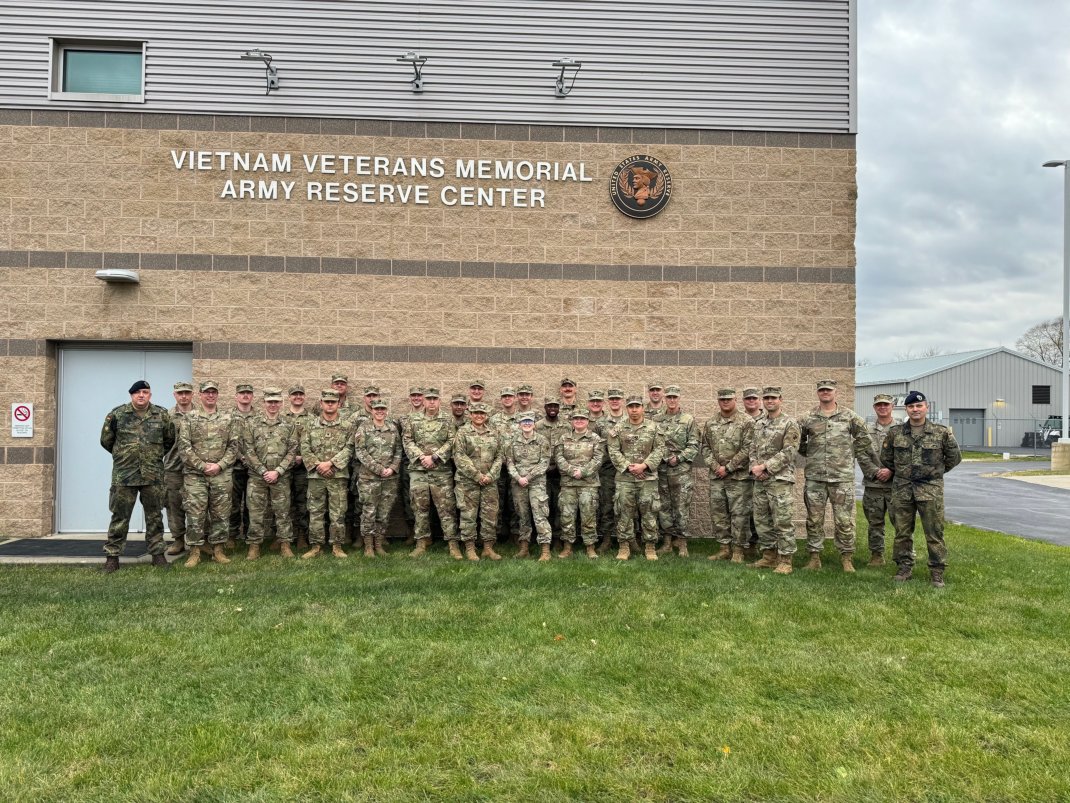
Both the US Educational Training Facility, the John F. Kennedy Special Warfare Centre and School (SWCS), and the US Operational units responsible for the European Area of Operations have a signed agreement with the CCOE in 2023.
The agreements intend to form the basis of further dialogue and cooperation between the entities. The purpose is, to institutionalize the cooperation.
The fields of cooperation are:
Ø Instructor exchange;
Ø Training;
Ø Exchange Information and data;
Ø Collaboration on policy, concepts and doctrine development;
Ø Jointly strengthen the national and international networks.
The cooperation as of now and the way ahead
The cooperation between the CCOE and US CA has led to an extensive exchange of support and will be increased in 2024. In 2024, the CCOE will conduct three EMPCs for different US CA commands and units; both will send several instructors and subject matter experts to support this cooperation, and the mutual support in relation to the development of policies, concepts, and doctrines will also be increased. Additionally, the CCOE will support again the Security Assistance Group – Ukraine (SAG-U) with Mobile Training Teams (MTT) to train Ukraine CIMIC forces.
The CCOE looks forward to continuing this constructive, goal-oriented and very well-appreciated cooperation and hopes to welcome the USA as a sponsoring nation soon!
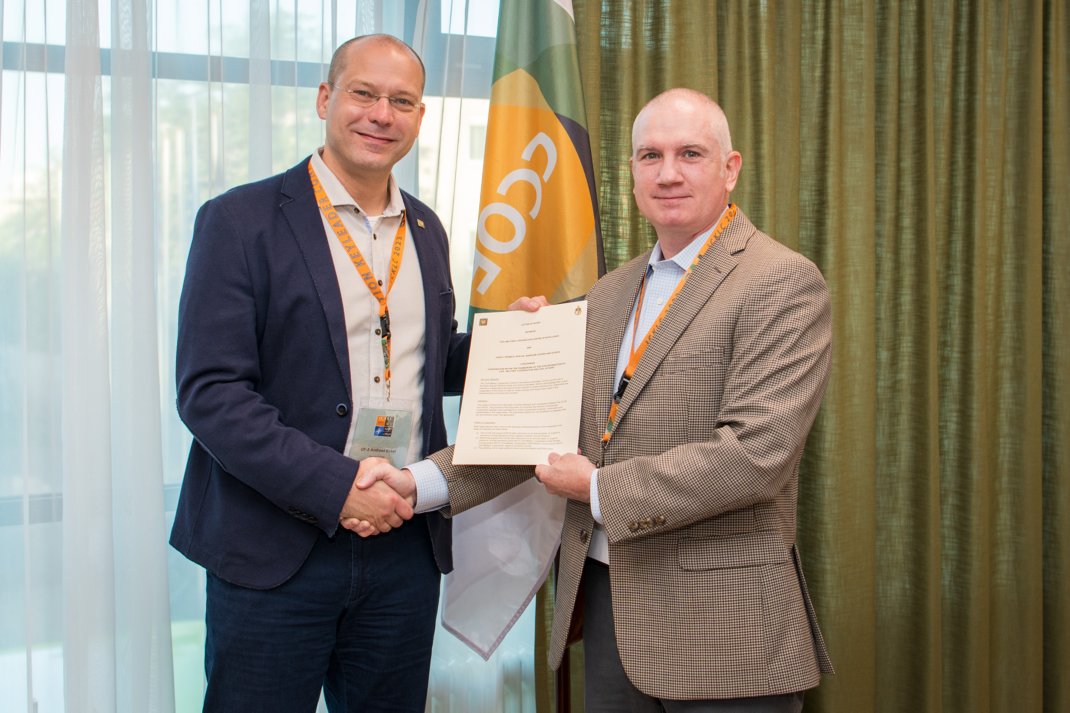
Periodic Assessment
NATO Centres of Excellence (COEs) are nationally or multi-nationally funded institutions accredited by NATO. They train and educate leaders and specialists from NATO member and partner nations, assist in doctrine development, identify lessons learned, improve interoperability and capabilities, and test and validate concepts through experimentation. They offer recognized expertise and experience that is of benefit to the Alliance and support the transformation of NATO while avoiding the duplication of assets, resources, and capabilities already present within the NATO command structure.
Although not part of the NATO command structure, NATO Centres of Excellence are part of a more comprehensive framework supporting NATO Command Arrangements. Designed to complement the Alliance’s current resources, they cover a wide variety of areas, with each one focusing on a specific field of expertise to enhance NATO capabilities. The overall responsibility for Centres of Excellence coordination and utilization within NATO lies with Allied Command Transformation, in coordination with the Supreme Allied Commander Europe.*
Under the conduct of ACT, all NATO-accredited COEs are periodically (every three years in principle) assessed to ensure they still meet the criteria approved by the Military Committee. These assessments are conducted to ensure that the products and services provided by a COE remain consistent with NATO standards and procedures and that COEs comply with agreed reporting and information requirements.
In 2024, a Periodic Assessment (PA) of the CIMIC COE will be executed by HQ SACT. The PA consists of two parts.
- The first part is a questionnaire, a self-assessment to be filled in by the CCOE itself.
- The second part of the PA is a Periodic Assessment visit by an Audit team from HQ SACT.
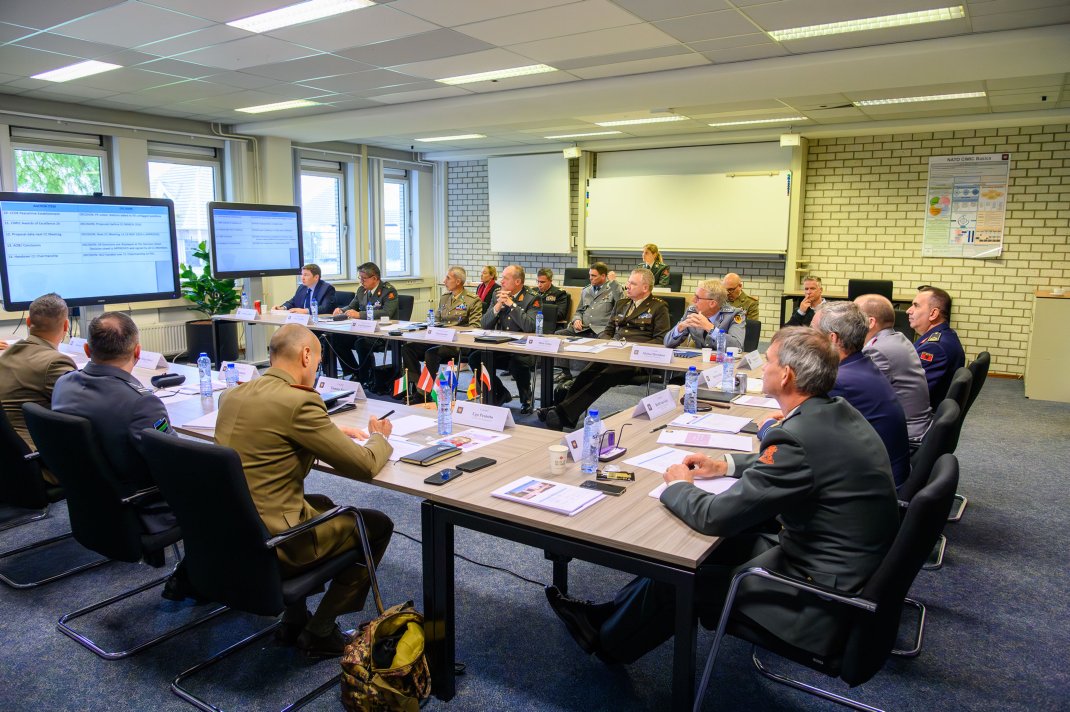
The completed questionnaire and the results of the audit will be included as an annexe to the HQ SACT’s Periodic Assessment Report. If the CCOE meets the criteria and passes the Periodic Assessment, HQ SACT will submit a report to the NATO Military Committee for notation.
In the upcoming months, CCOE staff will work on the self-assessment questionnaire. The PA Audit team will visit the CCOE on 10-12 JUN 2024. The CCOE team is very much looking forward to the direction and guidance from the ACT PA team to step forward and progress with a renewed accreditation!
(* see ACT definition of centres of excellence: https://www.act.nato.int/about/centres-of-excellence/)
The Israel-Hamas Conflict – Civil-Military Implications
An exemplary crosscheck
As we marked another year of Russia's aggression against Ukraine, 2023 was also marked by renewed humanitarian crises and armed conflicts, such as the war in Israel and Hamas in Gaza. The Civil-Military Cooperation Centre of Excellence (CCOE) recently published an article related to the ongoing Israel-Hamas conflict. This article examines the events that led to the hostilities between Israel and Gaza since October 7th, 2023. It all started with an attack on that date by Hamas forces, which resulted in a counteroffensive from Israel. The analysis by CCOE was done from a NATO doctrinal and policy perspective and focused on the challenges and tasks related to civil-military cooperation.
The multiplication and escalation of conflicts worldwide in urban areas as well as highly and increasingly populated areas make it more and more complex for military operations to respond to threats or conduct operations. To operate effectively, apart from ensuring military dominance on the battlefield, it is crucial to outmanoeuvre the opponents, achieve escalation dominance and target precisely enemy positions and entities in the civil environment – and minimize the threat to it as possible. A need for a capability that can interlink, evaluate and assess the impact of the civil factors in the operating environment is essential. The unfolding of the conflict in Gaza underscores the importance and necessity for civil-military cooperation in combat operations.
The Gaza conflict shows that civilian populations are the unintended victims during fights or can even be targeted and/or misused in various ways, including attacks on their critical infrastructure, denial of basic provisions and services, or covering military activities amongst them. The military forces face the challenge of defeating threats from outside the civil environment while simultaneously minimising harm to civilians. Like Hamas, adversaries may try to keep populations in place to cover and protect their activities and exploit any negative public and media opinion on military actions harming those. Protecting civilians in urban areas requires a comprehensive approach to anticipate and mitigate civilian risks and ensure compliance with International Humanitarian Law and Human Rights law.
Military decision-makers must comprehensively understand the operating environment not only from a legal (“Are we allowed to?”) or physical (“Can we?”) but also from a human security perspective (“Should we?”). The Concept of Human Security and its underlying cross-cutting topics (CCTs) are directed towards identifying and addressing the risks and threats faced by the population in conflict or crisis zones and how to respond to these. Although CCTs are not the military's primary responsibility, they can be utilised to understand the risks against civilians and prevent and mitigate risks in the operating environment. Their character for Alliance operations is mandatory, as all Alliance member states endorse.
Effective civil-military cooperation could play an essential role in safeguarding civilian lives in Gaza and or any other operation in highly populated urban terrain. By integrating the understanding of the civil factors in the military operation, a better understanding of the human environment of the conflict is created, and by that, the military objectives as part of comprehensive campaign objectives are supported. This includes assessments on population density and movements, critical infrastructure and provision of basic needs (e.g., along the seven baseline requirements), and context-specific threats and risks to civilians and objects, like cross-cutting topics. Mitigating war’s cruelty by balancing military necessity with humanitarian aims stresses the importance of having an entity to help coordinate the activities of civilian and military authorities.
In NATO doctrine, CIMIC provides the Commander with an integrated understanding of the civil factors (CFI) in the operating environment and enables, facilitates, and conducts civil-military interaction (CMI) to support the accomplishment of the mission. CMI activities contribute, e.g., to force acceptance, mitigating harm against civilians, support facilitating access to basic needs, freedom of movement, and the means and capacities to create the conditions for a safe and secure environment for the civilian population present in the operating environment.
CIMIC, as a joint function in multi-domain operations, is essential to NATO’s dedication to operating at the highest levels of intensity and complexity. This includes providing civil factor integration (CFI), participating in comprehensive planning, contributing to the joint targeting process, participating in essential working groups and boards, and directing civil-military interaction (CMI) activities based on analysis and assessment. These efforts are necessary to maintain the credibility and legitimacy of NATO as a military force.
“CIMIC can be a force for change by empowering military commanders to embrace a comprehensive approach to protect people and peace.”
Source based on an article from DCAF Ambassador Nathalie Chuard
https://geneve-int.ch/de/interview-nathalie-chuard
Academic Network & Partnership Forum
The Expanding Academic Network of the CCOE: Strengthening Partnerships and Forging New Opportunities
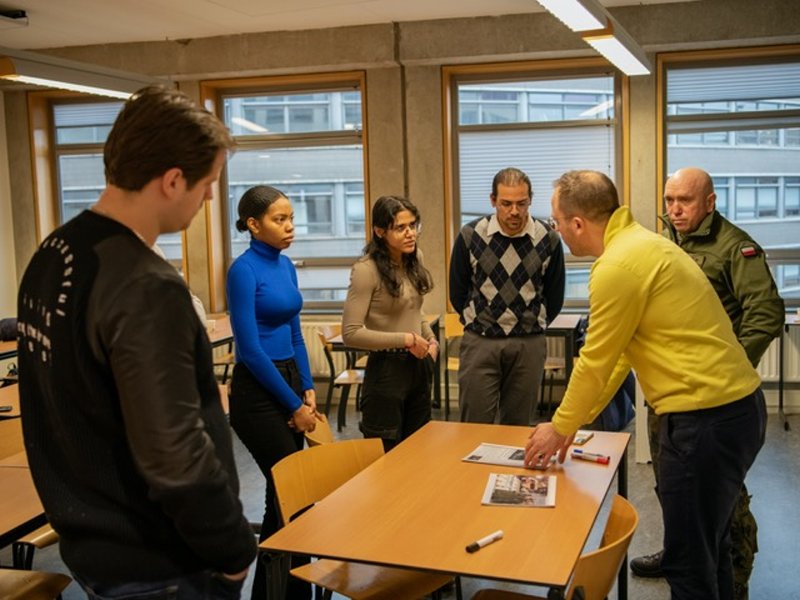 The significance of civil-military cooperation and the necessary networking cannot be overstated in an ever-changing global landscape. Acknowledging this, the CIMIC Centre of Excellence (CCOE) has been diligently working towards expanding its academic network. This article delves into the CCOE's endeavours to establish and maintain new partnerships, expand existing ones and create new avenues for interaction and collaboration, with a keen focus on future intentions.
The significance of civil-military cooperation and the necessary networking cannot be overstated in an ever-changing global landscape. Acknowledging this, the CIMIC Centre of Excellence (CCOE) has been diligently working towards expanding its academic network. This article delves into the CCOE's endeavours to establish and maintain new partnerships, expand existing ones and create new avenues for interaction and collaboration, with a keen focus on future intentions.
THE PRESENCE: Stabilising existing partnerships
Academic partnerships are of utmost importance in ensuring the success and effectiveness of the CCOE. Recognizing the value of stable collaborations with academic institutions, the CCOE has established long-term relationships that offer many benefits. These partnerships grant access to cutting-edge research, a diverse range of expertise, cross-domain and forward-looking, and extensive knowledge in various fields. Moreover, they foster innovation and enhance the CCOE's ability to address complex challenges and influence the transformation of the North Atlantic Alliance to better cope with future challenges. By collaborating with universities and research institutions, the CCOE can stay abreast of the latest advancements in all matters of civil-military aspects, CIMIC and related disciplines. This collaboration serves as a platform for knowledge exchange, joint exercises, common research, and the development of innovative solutions.
More specifically, academic partnerships provide valuable opportunities for the CCOE to enhance its training and education programmes. The collaboration with the Helmut Schmidt University regarding the Master of Arts in Civil-Military Interaction (MCMI) elevated the CCOE to an academic level. By working with universities and academic experts in general, the CCOE can furthermore incorporate the latest research findings and methodologies into its training curricula. For instance, at the NATO CIMIC Analysis & Assessment Course, the CCOE implements knowledge and experience from Glasgow University and OTH Regensburg, ensuring that CIMIC practitioners receive the most up-to-date and relevant knowledge and skills. This enables them to address their complex challenges in the field effectively. To further stabilize existing partnerships, the CCOE actively engages with academic partners through specific internships linked to defined projects, for example, the conceptualization of control documents or the re-assessment of publications. The CCOE benefits from students' experiences and learning skills, while the interns will highly benefit from the international working environment and close inclusion in specific projects. The exchange of subject matter experts to support CCOE courses, academic projects, and university classes is another high-end element of the partnership.
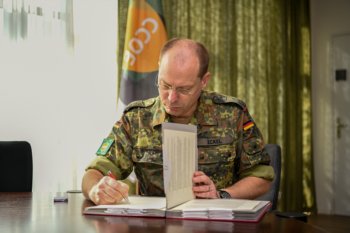 The connections facilitate knowledge exchange, collaboration on joint projects, and the sharing of best practices. For example, the CCOE has established new connections through Glasgow University to the University of Trento, which actively engages with Glasgow’s gaming lab, famous for its wargaming exercises “Damocles” and “Tempest”. That might be of high interest for future involvements in serious gaming, as wargaming is not only an attractive way to learn but also a necessity to be involved in. Another newly made connection is the admission to the pool of experts provided by NATO’s Science & Technology Organization. This enormous knowledge hub offers various new projects to commit to and new connections to engage with, for example, an established Bulgarian project about building resilience in mass movements. Such networking opportunities strengthen the CCOE's position as a leading centre of excellence in CIMIC.
The connections facilitate knowledge exchange, collaboration on joint projects, and the sharing of best practices. For example, the CCOE has established new connections through Glasgow University to the University of Trento, which actively engages with Glasgow’s gaming lab, famous for its wargaming exercises “Damocles” and “Tempest”. That might be of high interest for future involvements in serious gaming, as wargaming is not only an attractive way to learn but also a necessity to be involved in. Another newly made connection is the admission to the pool of experts provided by NATO’s Science & Technology Organization. This enormous knowledge hub offers various new projects to commit to and new connections to engage with, for example, an established Bulgarian project about building resilience in mass movements. Such networking opportunities strengthen the CCOE's position as a leading centre of excellence in CIMIC.
THE FUTURE: Creating new opportunities
In addition to stabilizing existing partnerships, the CCOE is dedicated to creating new opportunities for collaboration. This involves reaching out to academic institutions that have not yet been engaged with the CCOE. By expanding its network, the CCOE can tap into a wider pool of expertise and perspectives, enriching its research and operational capabilities.
It has also been actively participating in academic conferences, seminars, and symposiums worldwide, covering a range of topics such as Climate Change, Operations Research and Analysis, and Strategic Foresight. These platforms provide a valuable opportunity to showcase the CCOE's work, establish new connections, and explore potential areas of collaboration. One of those areas of interest might be a Canadian project about nature-based solutions to protect coastal regions from Climate Change or arctic research – topics the CCOE monitors but, first of all, uses to connect to different institutions. The CCOE aims to foster a vibrant academic network that can advance civil-military cooperation by actively seeking new partnerships. This endeavour will continue in the future to ensure the CCOE's visibility within different communities.
The CCOE has ambitious plans to strengthen its academic network further. In additionally to the previously mentioned opportunities, one of the key intentions is to establish a partnership forum for collaboration with academic institutions. This platform will outline the partnership's expectations, responsibilities, and benefits, ensuring a mutually beneficial relationship. Additionally, it will offer the opportunity to publish research projects and inform about news, updates, and engagements with other parties that might interest the CCOE and other network partners. The partnership forum will serve as a communication tool and platform to inform the community of interest and offer a place to publish and share your own work projects, papers and ideas.
Furthermore, the CIMIC Centre of Excellence (CCOE) aims to enhance its research capabilities by establishing specific joint research projects with academic partners. These projects will address students of the academic partners and focus on emerging challenges in civil-military cooperation and developing innovative solutions. By combining the expertise of academia with the practical knowledge of the CCOE, these research projects will contribute to the advancement of Civil-Military Cooperation. Additionally, these research projects could serve as valuable contributions to the collaborative workshops that are also being planned. These workshops will involve a well-balanced mix of academics and partners to ensure a comprehensive approach. The research projects can provide a solid foundation for further discussions and exploration of ideas. The CCOE is actively working towards implementing these plans and aims to bring them to life in October 2024.
Future visits and contributions to academic exercises, for example, GLOBE by OTH Regensburg, are on the agenda for academic partnerships of the CCOE as well, which will strengthen the intensity of collaboration further. The involvement of the CCOE’s long-term partner, West Point Academy, is also being renewed to give cadets the opportunity to “grow” within the CCOE structure and act as an instructor linked to a mentor. Exchanging information about upcoming events leads to an already trusting relationship.
To sum it up:
The expanding academic network of the CCOE demonstrates its dedication to excellence in Civil-Military Cooperation. Through stabilising existing partnerships and creating new opportunities, the CCOE is laying the foundation for improved research, knowledge exchange, and operational effectiveness. As the CCOE continues to expand its academic network, it is positioned to significantly impact the future of Civil-Military Cooperation.
Exploring the Power of CIMIC: A Journey through the upcoming CCOE Webinar Series Events
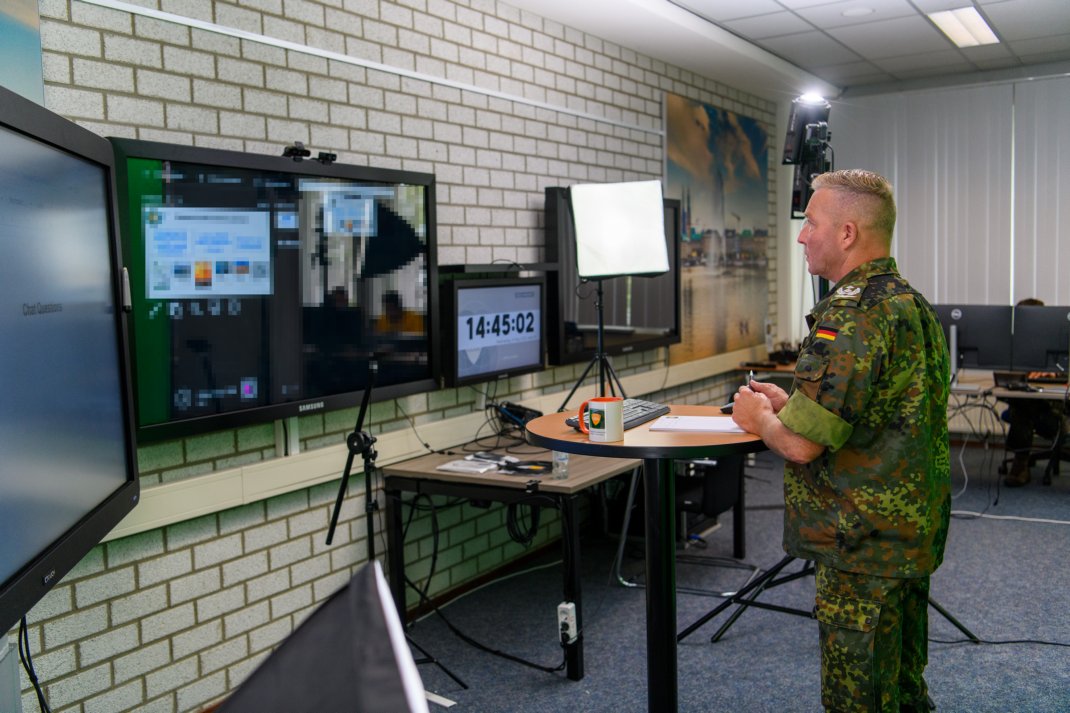
What if you could embark on a journey that takes you deep into the heart of CIMIC, exploring its power and potential…?
Welcome to the CCOE Webinar Series world, where we dive into the fascinating realm of Civil-Military Cooperation and its ever-evolving landscape. Join us as we unravel the complexities, uncover the latest trends, and engage in thought-provoking discussions with experts, professionals, and enthusiasts from around the globe. From humanitarian case studies to civilians in conflict, NATO CIMIC evolution and severe gaming, each webinar event promises to be a captivating exploration of the diverse facets of CIMIC. So, fasten your seatbelts and get ready to embark on an enlightening journey through the upcoming CCOE Webinar Series events in 2024!
MAR 2024: Israel-Palestine: A Humanitarian Case Study
In the heart of the Middle East lies a land shrouded in conflict and controversy, where the clash between Israel and Palestine has ignited a firestorm of emotions and tensions that have reverberated across the globe. This is a tale of two nations, bound by history and divided by ideology, where every step forward seems to be met with two steps back. Brace yourself as we delve into the depths of the Israel-Palestine crisis from a CIMIC perspective, a gripping saga that continues to captivate the world's attention…
This event in March 2024 marks a pivotal moment in the CCOE Webinar Series, as it tackles a pressing and highly relevant issue that demands our attention and understanding. The ongoing conflict between Israel and Palestine has far-reaching humanitarian implications, affecting the lives of countless individuals in the region and capturing the world's attention. By delving into these intricacies, this session aims to shed light on the recent escalation of the conflict and complex dynamics between Israel and Palestine, with a particular focus on the humanitarian challenges faced by the people of Gaza.
Through a comprehensive analysis of the challenges and the profound impact on civilian populations, this webinar seeks to cultivate empathy, understanding, and meaningful dialogue. It will explore the crucial role of CIMIC in promoting humanitarian assistance, peacebuilding, and conflict resolution in this highly sensitive region. Moreover, by inviting experts and stakeholders to share their invaluable insights and perspectives, this event provides a platform for knowledge exchange, awareness-raising, and fostering potential collaborations for future humanitarian endeavours.
JUN 2024: Civilians in Conflict: A Ukraine Case Study
Once upon a time, a nation caught in the clutches of a profound division existed in the heart of Eastern Europe. It was a land torn between the echoes of its past and the uncertainty of its future. The Ukraine conflict has captured the world's attention with its complex history, geopolitical implications, and devastating consequences. From the annexation of Crimea to the ongoing battles in the Donbas region, this conflict has sparked debates, fuelled tensions, and left a lasting impact on the lives of millions.
This presents an unique opportunity to examine the profound impact of conflict on civilian populations and explore effective strategies for mitigating harm and safeguarding vulnerable individuals from a CIMIC perspective. With a specific focus on the Ukraine crisis, which has unleashed a wave of humanitarian challenges, including displacement, loss of life, and the decimation of vital infrastructure, this webinar aims to shed light on the intricate complexities and daunting challenges faced by civilians in conflict zones. By examining the humanitarian aspects of CIMIC in these volatile areas, our goal is to raise awareness, foster a deeper understanding of the far-reaching consequences of conflicts on civilian populations, gain valuable insights into the intricacies of CIMIC in such environments, and identify best practices for promoting the well-being and safety of civilians. Together, we will explore strategies for mitigating harm, protecting civilians, and advancing peacebuilding efforts.
Join us as we look into the depths of this crisis from a CIMIC perspective, exploring its origins, the key players involved, and the quest for peace in a land caught in the crossfire.
SEP 2024: NATO CIMIC Evolution - A Virtual Roadshow
What does CIMIC actually mean?
Who has the authority to define it?
Why are definitions even crucial for operational efficiency and success?
And how do these definitions come into play?
Questions that may have crossed your mind on your CIMIC journey. But now, the answers are more diverse, varied, and even thrilling to explore. This session aims to unravel the evolving definitions of CIMIC, providing clarity and comprehension of its joint function and the structural changes of cross-cutting topics within NATO doctrines.
Embark on a doctrinal expedition and gain profound insights into how CIMIC is defined and how its components synergistically operate as a joint function, seamlessly interacting and translating plans into action.
NOV/DEC 2024: Unveiling the Power of Serious Gaming
Imagine an ever-evolving world where learning and entertainment seamlessly merge, where virtual realms become the playgrounds of knowledge and skill. In this realm of imagination, serious gaming reigns supreme, captivating minds and revolutionizing the way we learn, train, and engage with the world around us. Stepping into the realm of serious gaming, where imagination becomes a reality and the possibilities are endless, is a necessary step not only for economists and civil practitioners but also for the military as it faces complex changes in the future. Serious gaming, also known as gamification, has taken the world by storm, transforming the way we learn, train, and engage with various industries, especially with regard to the digital transformation humanity is continuously experiencing. From education to healthcare, serious gaming has proven to be a powerful tool in enhancing skills, fostering teamwork, and promoting critical thinking. In the realm of the military, serious gaming has emerged as a game-changer, revolutionizing training methods and preparing soldiers for the complex challenges they may face on the battlefield. With its immersive and interactive nature, serious gaming has become an indispensable asset for the military, providing a realistic and safe environment to simulate combat scenarios, test strategies, and develop crucial decision-making skills.
By exploring the value of serious gaming in CIMIC, this webinar event will showcase its ability to provide a valuable opportunity to bridge the gap between theory and practice within the CIMIC universe.
AJP 3.19 CIMIC Roadshow
NATO is constantly assessing its challenges, learning from past experiences, and preparing for the future. The alliance has established doctrine and manuals to ensure its actions remain aligned and focused. However, clarifying and translating these plans into practical examples is essential to ensure their effective implementation. Although these examples were originally written on paper, it's worth explaining the narrative and intent on a personal level. The CCOE introduced a roadshow campaign during the previous AJP 3.19 update to achieve this. The success of this campaign has led to its repetition.
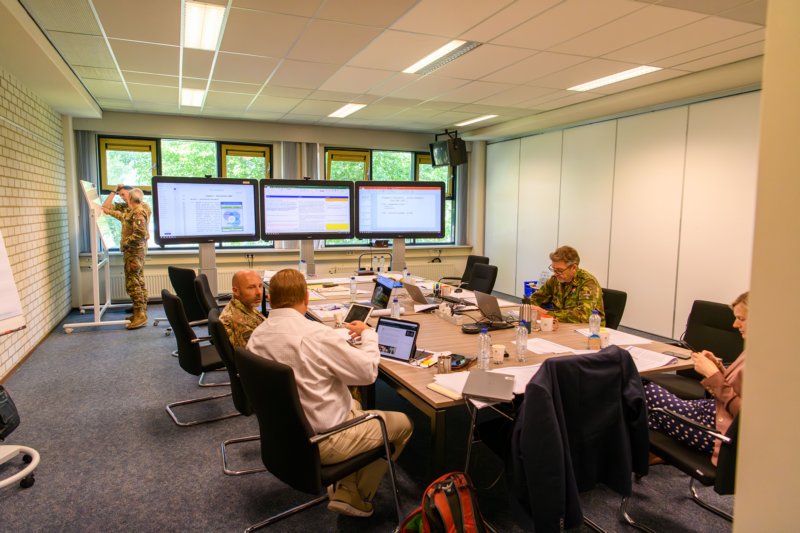 Therefore, in 2024, we plan to conduct a new roadshow campaign to inform you about the revised Allied Joint Publication (AJP) 3.19 CIMIC. The roadshow will offer a briefing provided by our subject matter experts. Currently, the AJP is handed over as a Ratification Draft to the NATO Standardisation Office (NSO) in Brussels, which is responsible for handling the document's formal ratification and promulgation process.
Therefore, in 2024, we plan to conduct a new roadshow campaign to inform you about the revised Allied Joint Publication (AJP) 3.19 CIMIC. The roadshow will offer a briefing provided by our subject matter experts. Currently, the AJP is handed over as a Ratification Draft to the NATO Standardisation Office (NSO) in Brussels, which is responsible for handling the document's formal ratification and promulgation process.
During the briefing, we aim to provide an overview of the operationalization of the Joint Function CIMIC, which has resulted from changes in the doctrinal landscape and the operating environment. We intend to address the following topics: NATO's current and future operating environment, CIMIC as a joint function, the CIMIC core activities such as Civil Factor Integration and Civil-Military Interaction, and CIMIC's path forward.
In any case, the brief's content will be tailored to the audience as required or requested. The briefings will be conducted in a "NATO UNCLASSIFIED releasable to PfP" environment.
If you would like to receive the briefing, please contact our point of contact, OF-4 Johan JANSON, at VOIP +31 889 566 455 / Mobile +31625245589 or email: CIC@cimic-coe.org; Janson.j@cimic-coe.org. We will then assess, on a case-by-case basis, whether a personal visit by our staff, VTC, or a visit from your side to the CCOE is sufficient to provide the briefing.
We look forward to your response and meeting you at your place, by VTC, or in The Hague.
Civil-Military Cooperation in Multi-Domain Operations
“The urgency for the Alliance to conduct multi-domain operations (MDO) is based on the rapidly changing security environment reflected in NATO’s new Strategic Concept. Simply put, it is more, faster and everywhere. We must change our model of warfare. Because of the intensity, the speed, and the versatility of threats that are no longer essentially military…”.
(General P. Lavigne)
In October 2023, the Supreme Allied Commander Transformation (SACT), General Phillipe Lavigne, welcomed the NATO MDO Conference in Copenhagen with a speech that conveyed a significant shift in NATO's operational planning. He emphasized the importance of a multi-domain mindset considering military and non-military assets, marking a paradigm shift from pure joint thinking. This new approach to warfare and operational planning recognizes the need for a broader definition of multi-domain operations that includes various operational domains beyond traditional military domains. The difference between the MDO approach and the classical joint approach lies in the way of thinking. “Joint” describes “activities, operations and organizations in which elements of at least two services participate”. The MDO approach is effects-oriented and is defined as:
„The orchestration of military activities across all operational domains and environments, synchronised with non-military activities to enable the Alliance to create converging effects at the speed of relevance.”
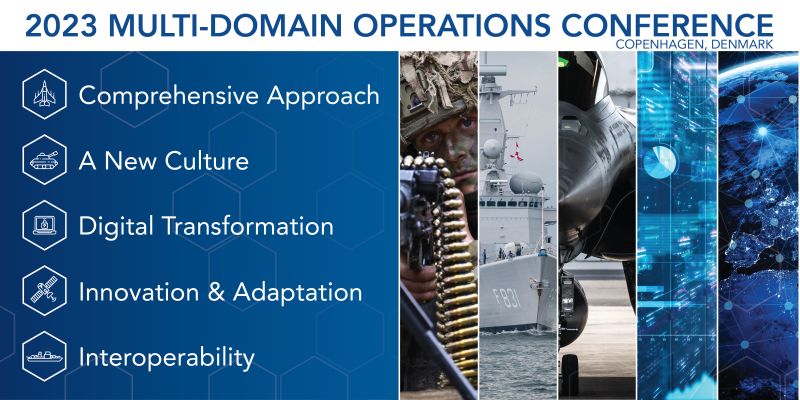
Operational domains represent specific spheres of military activity within the engagement area and provide a framework for organising the military instrument. There are five operational domains: Maritime, Land, Air, Space, and Cyberspace. The Space and Cyberspace domains are particularly noteworthy because, historically, joint military operations have rarely or never been carried out in them alone. However, the abilities of today's adversaries to influence these domains, the speed at which information spreads across all domains, and the worldwide access to cyber make it essential to synchronize military activities across all domains.
As the domains of cyberspace and space diversify, the number of actors and stakeholders involved increases significantly. These actors and stakeholders are not limited to the military but also include non-military international partners, private industry, and academic circles. These non-military actors can provide capabilities that the Alliance itself may not have access to but which it needs. NATO may become dependent on these non-military actors. Therefore, it’s crucial to analyse the potential risks of these dependencies, consider possible conflicting needs for these limited capabilities (both military and civil), and find ways to mitigate limitations on the military operation. But what means of synchronization does the Alliance have, and how can they be used? It is worth taking a look at NATO's Joint Function Framework, as described in AJP 01:
„The joint functions framework assists commanders to integrate political, military and civil actions through the operational domains.”
The Joint Functions Framework is useful for coordinating military and non-military activities. It helps determine the roles and influence of stakeholders in different domains and identifies which non-military actors need to be influenced and how. With NATO's eight interconnected joint functions, commanders and their staff can quickly streamline planning processes across all domains.
In non-military contexts, Civil-Military Cooperation (CIMIC) plays a significant role, as evidenced by its definition:
„CIMIC is a military joint function that integrates the understanding of the civil factors of the operating environment, and that enables, facilitates and conducts civil-military interaction to support the accomplishment of missions and military strategic objectives in peacetime, crisis and conflict.”
Understanding the civilian factors in an operational environment requires knowledge of all actors, their intentions, capabilities, and other relevant non-military factors. We call this knowledge management "civil factor integration," which involves integrating all factors into our planning processes and the commander's and staff's comprehensive knowledge. This knowledge is essential for tailored interaction with non-military actors and is part of the essential requirement for understanding the operating environment. As part of the civil factor integration, we prepare usable advice for future interaction with non-military actors using professional CIMIC analysis and assessment skills. Based on this CIMIC advice, “civil-military interaction” with stakeholders and other non-military actors can occur at different intensities, ranging from consultation to collaboration and integration. Determining the correct intensity and level of interaction is also an outcome of civil factor integration.
When we consider the concept of multi-domain operations in relation to the CIMIC joint function, we can see that many areas overlap. However, what really stands out is the additional benefit that the joint function provides in terms of coordinating both military and non-military activities. This extra value can be summarized as follows:
„CIMIC sets the conditions to synchronise military activities across all operational domains and environments with non-military activities to create converging effects.”
However, one might wonder if these changes are new and what they imply for CIMIC.
CIMIC is responsible for integrating the understanding of the civil factors of the operating environment by facilitating civil-military interaction and analysing non-military factors. However, NATO's shift towards a multi-domain and military-non-military perspective also impacts CIMIC's role. As a result, the following four points can be derived as being relevant:
1. CIMIC must be understood more than ever as a joint function in the associated framework. For CIMIC staff, this means that their profession's importance in analysis and assessment has increased, and they need to present it in a way that the staff and the commander can use. Additionally, this capability must be available seamlessly from the strategic to the tactical level. It's important to understand that the function of CIMIC is not only conducted by specialised CIMIC staff. All military personnel contribute to determining the situation, which is equally important than the assumed exclusive abilities of individual field workers. This is what the CIMIC joint function has in common with other joint functions.
2. In NATO, MDO is primarily a concept, a mindset, and an attitude that needs to be operationalized by creating plans at all levels. To integrate this mindset into the respective plans, the CIMIC staff needs people who are aware of this mindset and can apply it in all planning phases or the execution of operations. This affects the timing of decisions, the integration of non-military partners into processes, and the derivation of conclusions for future operations. Since non-military stakeholders can also be involved in planning processes, civil factor integration (CFI) must begin as early as possible as a prerequisite for civil-military interaction.
3. Viewing CIMIC's role in MDO regarding domains rather than individual capabilities is essential. This means considering the domains from the perspective of non-military stakeholders. For instance, what is the effect on military operations of a satellite system used for military purposes but operated by civilians? What is the goal of a protest by a non-military group in a NATO country, and who or what is in control? How strong is the societal resilience in a NATO country, and what impact does it have in the event of an attack on NATO territory? As demonstrated by the experience of Ukraine, a well-informed analysis of these non-military factors is crucial. To achieve this, CIMIC staff must think creatively and use the expertise of those they analyse, not relying on military stakeholders only.
4. The CIMIC staff faces challenges by thinking in multi-domains and military and non-military spectrums. This approach requires good education, regular training, and practice of basic skills in the areas of analysis and assessment and civil-military interaction. It is well-known that the acceptance of CIMIC advice increases with persuasive content and presentation. While this is not new, MDO can serve as an opportunity to reinforce the importance of these factors and CIMIC as a Joint Function.
The new CIMIC Handbook
We all work in CIMIC and have either been on a mission, participated in exercises or training, or will do so in the future. We often face time constraints and don't have access to the complete library of CIMIC documents. Sometimes, having practical examples of contributions or products in an easily accessible format would be extremely helpful. A handbook could be the solution to provide initial guidance.
In the middle of 2000, the CIMIC Centre of Excellence established the CIMIC Handbook series. This series aims to provide tactical reference and operational command-level insight for all personnel involved in CIMIC across the full mission spectrum. The secondary objective is to create awareness for those organisations and actors interested in NATO CIMIC.
After 4 versions, which were available in a paper pocket-size format, the CCOE released the first online version of the Handbook in 2019. This version was created to update us with continuous internal and external feedback and immediate adaptation. In the light of continuous fast dynamics in the security environment and related changes within NATO’s policy, doctrine, and publication landscape, it becomes necessary to shift the Handbook to another level and conduct a holistic review that requires broad internal and external contributions.
The CCOE executed the first Workshop in November last year to set the scene for the new Handbook. Hosted by the CCOE, members of the MNCG, LANDCOM, DEU MN CIMIC Cmd, NLD 1st CMI Cmd, and POL MTCFO worked together to adapt the content to the current security environment and ensure a tangible structure tailored to the needs of the customer of the new version of the Handbook.
The next workshop will be conducted from February 27th to 29th to discuss and decide on the content of the several chapters that every participant of the working group drafts.
The new CIMIC Handbook will have a totally new structure. It will be more tangible for the practitioners and focus on how to do CIMIC in Staff and fieldwork with the main effort on the higher tactical level. It will be adapted to the current doctrine landscape.
The aim is to publish the new version at the end of the second quarter 2024. Until then, please use our website's current version of the CIMIC Handbook.
If you have any questions, remarks, or content-wise proposals, feel free to contact our point of contact, OF-4 Christoph SCHWIER, at VOIP +31 889566466 / Mobile +31652756722 or email: Schwier.c@cimic-coe.org.
Dobrodošli Slovenija - Welcome Slovenia
The support of Sponsoring Nations (SNs) is pivotal for the CCOE to fulfil its mission. Any drop out of an SN, therefore, constitutes a loss of support.
Therefor it was a loss for the CCOE that Slovenia (SVN) in 2020 announced not to man a SVN-flagged post in the CCOE PE anymore as of 1 AUG 2021. From that moment the post became unflagged and this was interpreted as SVN not being a SN of the CCOE anymore. However, this withdrawal as SN was never officially stated, so when 2023 SVN officially renewed its interest to return to the status as full SN of the CCOE, it became clear that the absence of SVN could be seen as a ‘dormant status’ of being a SN.
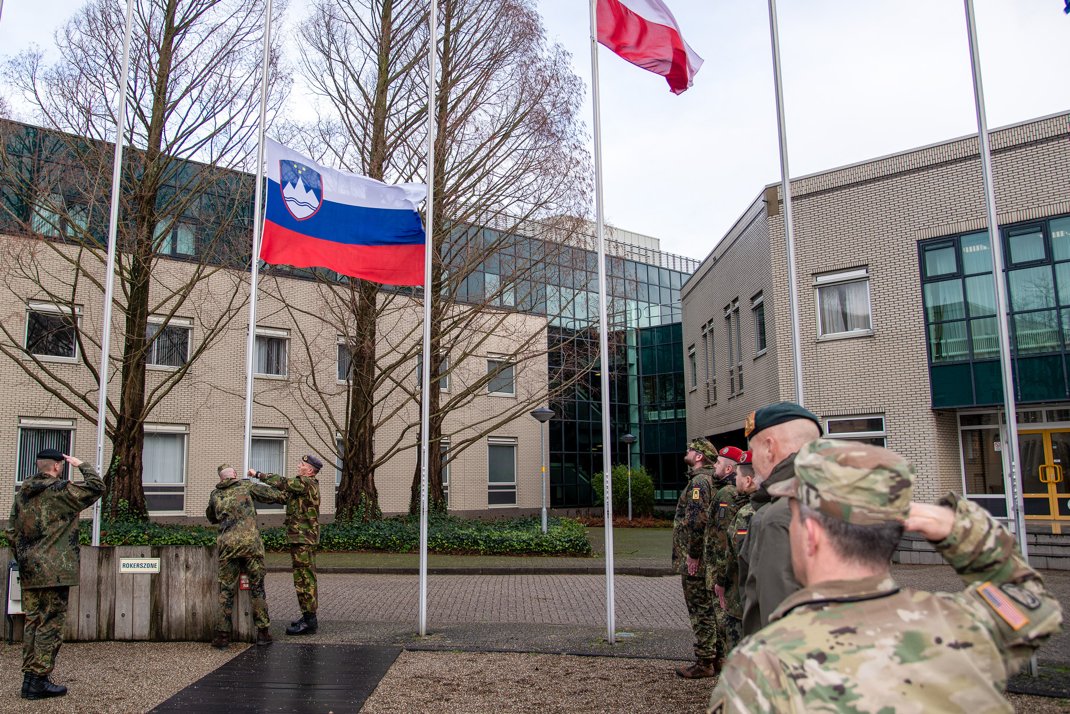
At the Coordinating Committee Meeting in November 2023, the SNs of the CCOE - Germany, Hungary, Italy, Latvia, The Netherlands and Poland - agreed that SVN will return to full membership status with all obligations and authorities as of the first of January 2024. As a clear visual sign of the integration of SVN in the CCOE, their flag was raised in the presence of all available national representatives. SVN also reflamed their original position within the T&E branch of the CCOE and will hopefully man this Staff Officer position whenever possible. So! Welcome back to the CCOE/ CIMIC team!
CIMIC wargaming for mission success in crisis and conflict scenarios
Events in recent history have led to a renewed appreciation of wargaming within NATO and national armed forces. Whether it is for education or analysis purposes, wargaming enables participants to engage with tough dilemmas in safe-to-fail simulated adversarial environments. Wargames generate insights into complex issues and challenges and provide a dynamic and responsive ´sand-box´ to test one's own answers or new concepts. Besides classic doctrinal COA wargaming, as outlined in the COPD, wargames enable participants to explore concepts such as Multi Domain Operations, Space warfare, Layered Resilience and the changing role of Civil-Military Cooperation (CIMIC) with relative ease.
Wargaming and CIMIC
Meanwhile, within the CIMIC community, there is a firm understanding that all military operations are executed within a complex civil environment. At the CIMIC Centre of Excellence (CCOE), we observe that this is not always the case outside the community. While military tactical and capability issues are well and in-depth represented, we observe that in many wargames organised by units or HQs, still too often, the complexity of the civil environment is ignored or underrepresented. CIMIC as a joint function is treated as an afterthought as it may not be fully appreciated, although clearly highlighted in NATO key/ capstone doctrine (AJP 01) or within the Alliance Warfighting Capstone Concept (NWCC). As part of this, NWCC, wargaming is incorporated as a key concept to support the campaign as Wargaming Initiate NATO (WIN) run by Allied Command Transformation in Norfolk, Virginia.
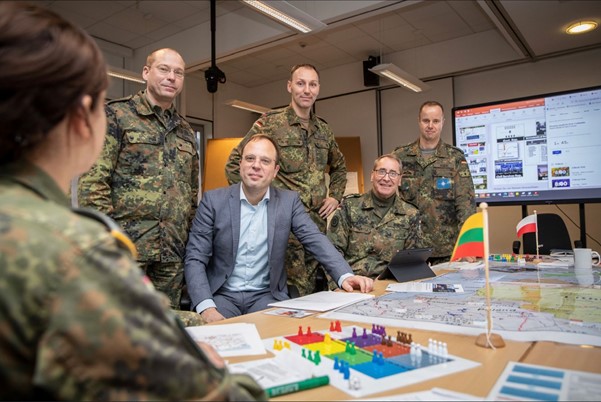
At the CCOE, we seek to remedy this by developing and executing CIMIC-focused wargames as part of all our knowledge development and training & education activities. The CCOE is even able to provide wargaming subject matter expertise upon request from NATO entities and sponsoring nations.
CCOE’s vision on CIMIC wargaming
As all military operations are executed within a civil environment, it is paramount that wargames reflect the fact that understanding and the appropriate integration of the key civil factors in military activities is essential and mission-critical. This means that the civil environment and CIMIC, as a joint function, should be integral characteristics within the design of any wargame. And, crucially, as to its development and execution.
How the CCOE uses wargames within its Training and Education activities
In educational environments, wargames and, more broadly, serious games offer a level of immersion that surpasses that of standard briefings. These games engage a person’s full range of faculties and cater to diverse learning styles, thereby enhancing the learning experience.
Within all of the CCOE’s courses, wargames and/or serious games are used to:
- provide insight into the role of CIMIC at all levels and stages of an operation. For instance, our wargames showcase the importance of Civil Factor Integration (CFI) as they enable participants to consider the influences and roles of non-military actors and elements within the operational context of NATO activities in order to develop and execute appropriate Civil-Military Interaction (CMI) and CIMIC strategies and activities.
- train typical CIMIC skills, such as liaison, information gathering and key leader engagement activities. Role-playing games, for instance, allow players to experience what it is like to negotiate with civilian actors on topics such as establishing a humanitarian corridor;
- educate CIMIC-related knowledge, for instance, how to assess a particular situation, apply the factor, deduction, and conclusion model using the PMESII framework, work with the baseline requirements and Resilience through civil preparedness, etc.
We deliver several serious games. Some example of CCOEs most notable games are described here: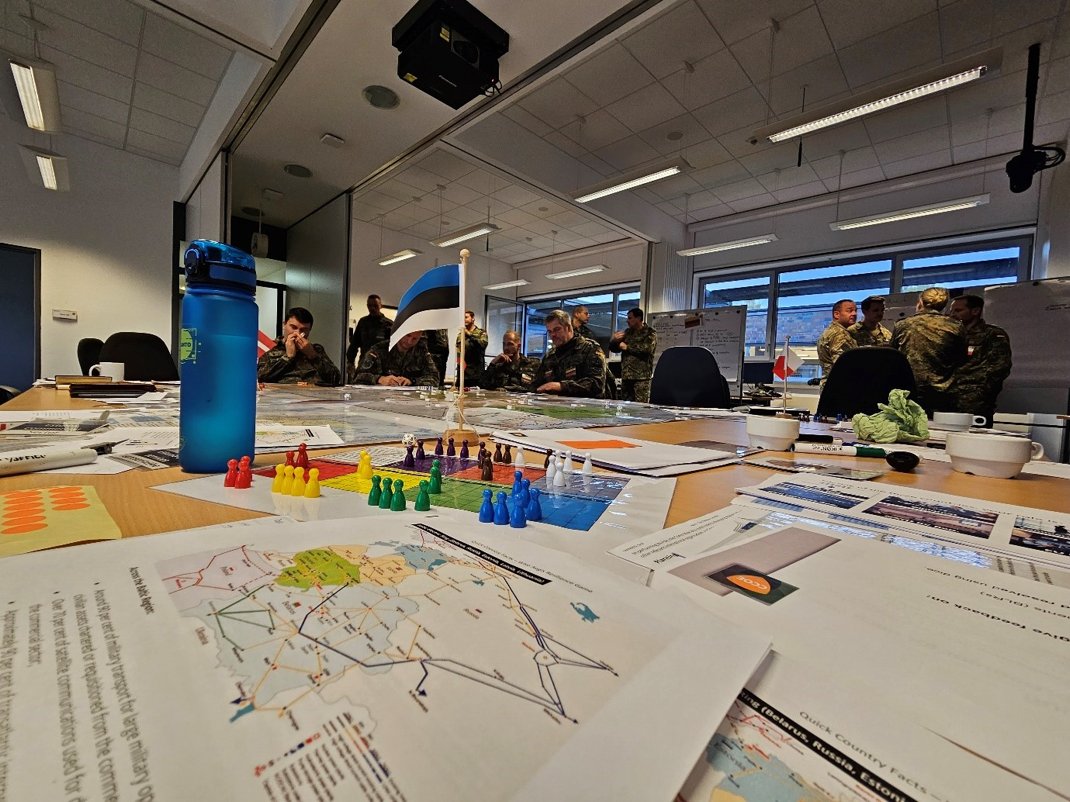
- WISE-AEGIS. This is a strategic wargame on resilience through civil preparedness (RtCP) in an Eastern European setting – which refers to the respective NATO concept of layered resilience. It provides participants with a concrete understanding of what resilience at the national level entails and how it relates to military activities in the region. Over the course of several rounds, participants take on roles and play in teams. Each team needs to overcome multiple shocks by developing and executing courses of action.
WISE-AEGIS is used in various CCOE courses, including the NATO CIMIC Higher Command Course (NCHCC) and the RtCP course. The CCOE also delivers WISE-AEGIS at the advanced command and staff course of Germany’s command and staff college (Führungsakademie der Bundeswehr). - Art IV– V wargame This is a wargame in which CIMIC topics are explored at the operational and tactical level using the factor, deduction and conclusion model in an article IV and V situation. In this competitive vignette-based exercise, participants play in teams. Teams are challenged to create quality knowledge products (briefings) over the course of several rounds. Participants apply the factor, deduction and conclusion model on predeveloped scenario materials relating to the various phases of armed conflict on NATO territory in two distinct settings: an Urban terrain and an Eastern European country. The outputs of the teams are judged by a team of experts. The game is played in rounds. Each round presents unique information and challenges. After each round, there is a time jump: from article 4 to a situation in article 5 and from article 5 to a post-conflict situation.
- Baltic Challenge. This tactical game is used to practice various soft skills in a recognisable European setting. Participants play in unique roles, representing multiple actors, and engage in key leader engagement and liaison activities. Over the course of the game, the participants receive different challenges, enabling them to think from a variety of perspectives (NATO, Civilian, Host Nation, Opposing Forces) as well as the use of a variety of means. A full overview of the (war)games currently used by the CCOE can be found on the CCOE website. In addition, the T&E branch is able to adapt existing wargames to fit unique requests, e.g. tailoring an existing wargame’s scenario to fit the needs of a specific unit.
How the CCOE uses wargames as part of its Concepts, Interoperability and Capabilities (CIC) branch activities
Upon request, the CIC branch provides subject matter expertise on wargaming and CIMIC to sponsoring nations and NATO entities. Our experts are able to provide crucial value to wargames being delivered by such parties by:
- developing wargames to test new CIMIC-related concepts upon request;
- contributing to the development of a war game. Our experts can help by ensuring that the civil environment and CIMIC as a cross-cutting topic are ensured in the wargame’s design;
- taking on a role in the cognition and analysis of wargame experiences. Providing an understanding of in-game player actions and, where necessary, operational analysis;
- foresight in order to assess and understand future concepts and trends in CIMIC, relate to the NWCC and WIN, and enable the CCOE to develop, execute and assess future CIMIC-focused scenarios using a variety of methodologies.
The CCOE’s Training and Education (T&E) branch has a vital role in disseminating knowledge produced by the CIC branch to wider audiences. A good example of this is the CIMIC Analysis and Assessment (A&A) concept. As part of this course, the CCOE is currently developing a new wargame that provides participants with a clear understanding of the importance of operating within a complex civil environment using key concepts from the A&A concept. In this wargame, participants are responsible for building a comprehensive environment and exploring the consequences of military activities in this environment. Subject matter experts provide vital input through briefings, dialogues and one-on-one discussions.
Invite to share your war and serious games.
At the CCOE, we are eager to understand what other CIMIC-related games are out there. If you have a CIMIC-related wargame or serious game that warrants a widespread adaptation within the CIMIC community, please get in contact.
Links:
https://www.cimic-coe.org/resources/fact-sheets/factsheet-wargaming-modelling-simulation.pdf

